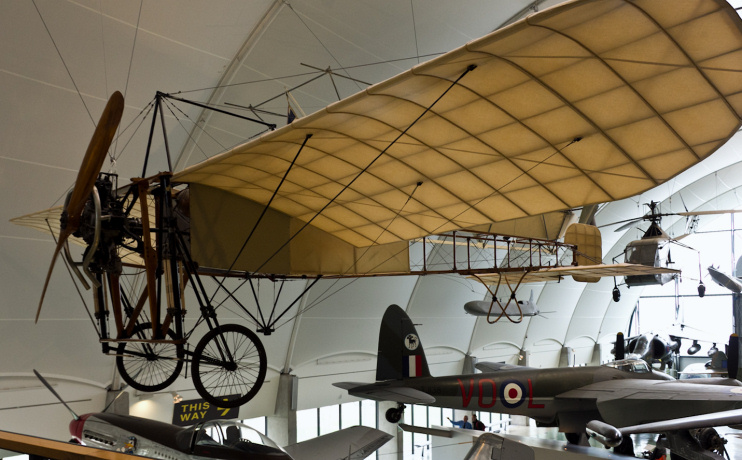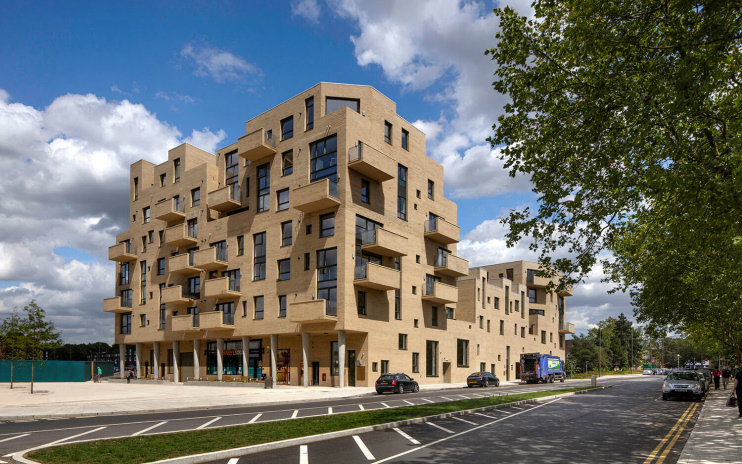Grahame Park
Grahame Park, Barnet
A residential estate in north-east Colindale, named after Claude Grahame-White, who established Hendon airfield here

Claude Grahame-White was a motor engineer who became obsessed by aircraft and their possibilities when Blériot made his triumphant crossing of the English Channel in 1909, in a plane like the one shown above.* Grahame-White immediately travelled to France and taught himself to fly, and soon became a frequent air-race contestant, winning many challenge races and flying by night.
He established an aircraft factory that would ultimately employ 3,000 people, founded the first British flying club and – in 1910 – created Hendon airfield on what had been several hundred acres of scrubby farmland. On top of all this he wrote technical manuals and co-authored works of aeronautical fact and fiction with Harry Harper, a Daily Mail journalist.
“The air will be our future highway, affording the fastest transit to passengers and goods; and, ere twenty-five years have passed; a fleet of sea-planes – devouring distance at tremendous speed – should fly from England to America in less than twenty hours. Not for nothing, after centuries of effort, have we conquered the air. Lives have been lost, the victory dearly won; but mankind, in the end, will benefit. First Europe will be linked by airway; then, by degrees, the world.”
Preface to The Air King’s Treasure, Claude Grahame-White and Harry Harper (1913)
In 1914 Hendon aerodrome was requisitioned by the government and by 1925 it was declared to be the property of the Royal Air Force – much to the aggravation of Grahame-White, who felt the government had treated him appallingly. A lengthy compensation dispute ensued and he eventually sued the government, winning the lawsuit but with little satisfaction at having done so. Grahame-White grew disillusioned with British flying activities and – turning to property investment and development – became a wealthy man and spent the remainder of his life in America and France.
Meanwhile, in the locality now named Grahame Park, aircraft were manufactured and flown from Hendon aerodrome until 1937, after which its enclosure by suburban housing made aviation impractical, although it operated briefly as a fighter station during the Battle of Britain. From 1940 RAF Hendon became a communications and training base, finally ceasing operations in 1957. The Greater London Council began construction of the Grahame Park estate on part of the former airfield in 1969.
Grahame Park was planned as a miniature new town, with municipal flats and houses at its core and private and Ministry of Defence housing on the perimeter. Community facilities included a library, church, day centre and health centre, all with angular designs.
Plans continued to evolve throughout the project’s implementation, generally in the direction of downscaling. Barnet council made some worthwhile efforts to prettify the estate in the early 1990s.
However, problems of crime and deprivation persisted and a renewal programme is presently transforming much of Grahame Park. Inevitably in such a scheme nowadays, most of the new accommodation is for private sale but homes will also be provided for existing Grahame Park residents, by the housing association Notting Hill Genesis.
The photo below (by Morley von Sternberg) shows Pegasus Court, designed by Peter Barber Architects and forming the eastern side of the new southern gateway square, part of the first phase of the Grahame Park redevelopment.

The project, which is one of the largest of its kind in London, was due for completion in 2020 but this target is unlikely to be met because the mayor of London rejected proposals for the the next renewal phase in December 2017, on the grounds that too many social homes would be lost. He called the plan a “classic example of how not to do estate regeneration.” Richard Cornelius, leader of Barnet council, was quoted as saying, “Mayor Khan … seems to want to create the sink estates of tomorrow by continuing to concentrate social tenants in one place. This is the wrong approach and we will be considering how to respond.”
Elsewhere on the site of the former aerodrome, London’s Royal Air Force Museum displays more than 100 planes from around the world, from some very early designs to modern jets and military aircraft. Several special exhibitions are usually in progress too. Admission is free, though you have to pay for a couple of extras, such as experiencing “all the thrills and exhilaration of powered flight” in the so-called 4D theatre.
Postal district: NW9
Further reading: The In-Betweeners, an excellent article about the regeneration of Grahame Park in the RIBA Journal (September 2015)
